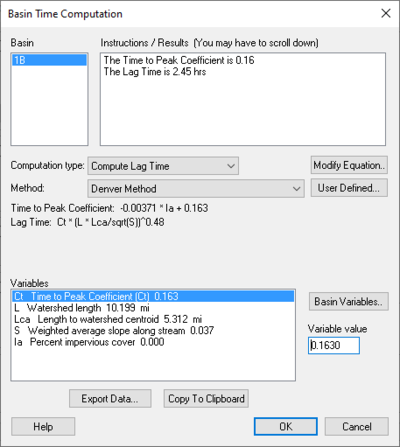WMS:Travel Times from Basin Data
WMS computes many geometric parameters when using the Compute Basin Data command for either a TIN or DEM. These parameters form the basis of the empirical equations used to compute lag time and time of concentration. The Basin Time Computation dialog allows selecting from a series of pre-defined equations (Dodson & Associates, 1992), or create a user-defined equation using any of computed basin parameters to compute the time of concentration or lag time. If the equation is a function of a variable not computed by WMS then enter the value in this dialog before a travel time can be computed. The process of computing travel times for a selected basin from computed basin data involves the following two steps:
- Select an equation (or create a new one).
- Follow the instructions provided in the Instructions / Results text window until all of the necessary data are correctly defined (also any of the variables computed by WMS can be edited).
Auto Recomputing
By default, once an equation is specified for a basin, the lag time and time of concentration will be computed automatically each time that basin data are computed or when the curve number changes. If not wanting to have the equation updated when basin data changes then turn on the Do not Auto-recompute parameters checkbox for the selected basin.
Exporting Results to a Report
The Export Data and Copy To Clipboard buttons are used to create a text report that summarizes the equation, variables, and computed time of concentration or lag time for the basin. Exporting the data will create a text file and allows either appending to an existing file (so that a single report for multiple basins can be created) or creating a new file. Copying to the clipboard places the report text on the Windows clipboard so that it is available for pasting into other documents.
Basin Time Computation Dialog
Accessed by selecting Compute Parameters-Basin Data in the HEC-1 Unit Hydrograph Methods dialog. Basin – Instructions / Results (You may have to scroll down) – Computational type: –
| Selections | Selection Options | ||
|---|---|---|---|
| Method: | "Denver Method"
"Tulsa Rural Method" – "Tulsa 50% Urban Method" – "Tulsa 100% Urban Method" – "Espey Rural Method" "Espey No Urbanization Method" "Espey Partly Urban Method" "Espey Completely Urban Method" "Riverside Mountains Method" "Riverside Foothills Method" "Eagleson Method" "USGS Nationwide Urban Method" "Putnam Method" "Taylor Method" "Colorado State University (CSU) Method" "Scs Method" "Custom Method" | ||
| User Defined... – | Select to bring up Modify Equation dialog. | ||
| Modify Equation... | Select to bring up the Modify Equation dialog that allows you to modify the equation used for the Basin time computation. | ||
| Basin Variables... – | Select to open the Basin Geometric Attributes dialog. |
| Selections | Selection Options | ||
|---|---|---|---|
| Method: | "User Defined Method"
"Kirpich Method for overland flow on bare earth" "Kirpich Method for overland flow on grassy earth" "Kirpich Method for overland flow on asphalt" "Kirpich Method for overland flow on bare earth (Mountains)" "Kirpich Method for overland flow on grassy earth (Mountains)" "Kirpich Method for overland flow on asphalt (Mountains)" "Ramser Method for channel flow" "Fort Bend County Method" "Kerby Method for overland flow" "ADOT Method (Desert/Mountain)" "ADOT Method (Urban)" | ||
| User Defined... – | Select to bring up Modify Equation dialog. | ||
| Modify Equation... | Select to bring up the Modify Equation dialog that allows you to modify the equation used for the Basin time computation. | ||
| Basin Variables... – | Select to open the Basin Geometric Attributes dialog. |
- Instructions – Place that allows the reading of warnings that may occur in the equation as well as a list of pre-defined variables that are computed by WMS.
Equation – The equation used for calculation.
- Parse – Click to parse through the equation.
Variable Abbreviations – A list of variable abbreviations relating to the equation. Definitions – A list of definitions for the variable abbreviations. Units – ||The units that apply to the definition chosen.
- "none"
- "ft"
- "m"
- "km"
- "mi"
- hr"
- "min"
- "sec"
- "sq. mi"
- "sq. km"
- "sq. ft"
- "acre"
- "hect"
- "in"
- "mm"
- "ft/mi"
- "fract"
Method:
Related links: https://www.xmswiki.com/wiki/WMS:Travel_Times_from_Basin_Data
https://www.xmswiki.com/wiki/WMS:Denver_Lag_Time_Equation
estimation of the channel velocity measured in feet per second.
Related Topics
- Assigning Equations to a Basin
- Customizing Equations
- Exporting Results
- Geometric Parameters Used by Equations
- Travel Times from Map Data
WMS – Watershed Modeling System | ||
|---|---|---|
| Modules: | Terrain Data • Drainage • Map • Hydrologic Modeling • River • GIS • 2D Grid • 2D Scatter |  |
| Models: | CE-QUAL-W2 • GSSHA • HEC-1 • HEC-HMS • HEC-RAS • HSPF • MODRAT • NSS • OC Hydrograph • OC Rational • Rational • River Tools • Storm Drain • SMPDBK • SWMM • TR-20 • TR-55 | |
| Toolbars: | Modules • Macros • Units • Digitize • Static Tools • Dynamic Tools • Drawing • Get Data Tools | |
| Aquaveo | ||
